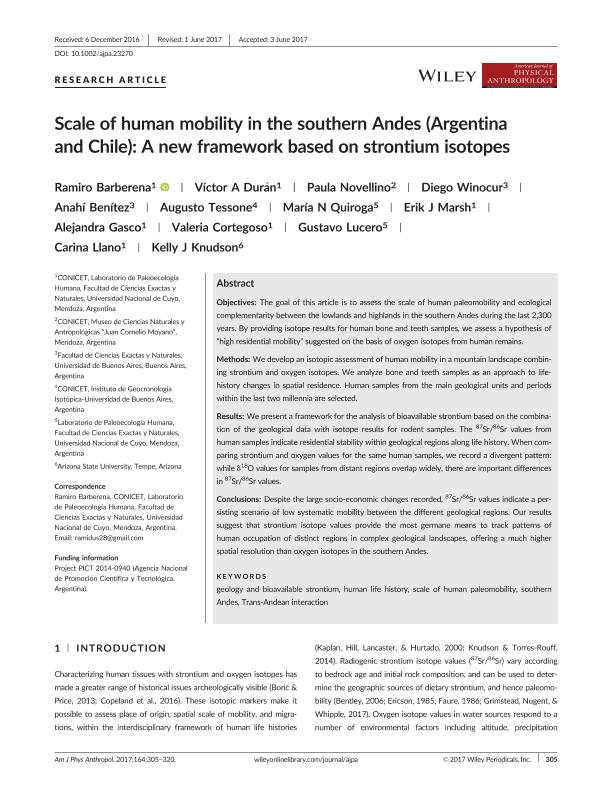Artículo
Scale of human mobility in the southern Andes (Argentina and Chile): A new framework based on strontium isotopes
Barberena, Ramiro ; Duran, Victor Alberto
; Duran, Victor Alberto ; Novellino, Paula Silvana
; Novellino, Paula Silvana ; Winocur, Diego Alejandro; Benitez, Angélica Anahí
; Winocur, Diego Alejandro; Benitez, Angélica Anahí ; Tessone, Augusto
; Tessone, Augusto ; Quiroga, Maria Natalia; Marsh, Erik Johnson
; Quiroga, Maria Natalia; Marsh, Erik Johnson ; Gasco, Alejandra Valeria
; Gasco, Alejandra Valeria ; Cortegoso, Valeria
; Cortegoso, Valeria ; Lucero Ferreyra, Gustavo Fernando
; Lucero Ferreyra, Gustavo Fernando ; Llano, Carina Lourdes
; Llano, Carina Lourdes ; Knudson, Kelly Jo
; Knudson, Kelly Jo
 ; Duran, Victor Alberto
; Duran, Victor Alberto ; Novellino, Paula Silvana
; Novellino, Paula Silvana ; Winocur, Diego Alejandro; Benitez, Angélica Anahí
; Winocur, Diego Alejandro; Benitez, Angélica Anahí ; Tessone, Augusto
; Tessone, Augusto ; Quiroga, Maria Natalia; Marsh, Erik Johnson
; Quiroga, Maria Natalia; Marsh, Erik Johnson ; Gasco, Alejandra Valeria
; Gasco, Alejandra Valeria ; Cortegoso, Valeria
; Cortegoso, Valeria ; Lucero Ferreyra, Gustavo Fernando
; Lucero Ferreyra, Gustavo Fernando ; Llano, Carina Lourdes
; Llano, Carina Lourdes ; Knudson, Kelly Jo
; Knudson, Kelly Jo
Fecha de publicación:
10/2017
Editorial:
Wiley-liss, Div John Wiley & Sons Inc
Revista:
American Journal Of Physical Anthropology
ISSN:
0002-9483
Idioma:
Inglés
Tipo de recurso:
Artículo publicado
Clasificación temática:
Resumen
Objectives: The goal of this article is to assess the scale of human paleomobility and ecological complementarity between the lowlands and highlands in the southern Andes during the last 2,300 years. By providing isotope results for human bone and teeth samples, we assess a hypothesis of “high residential mobility” suggested on the basis of oxygen isotopes from human remains. Methods: We develop an isotopic assessment of human mobility in a mountain landscape combining strontium and oxygen isotopes. We analyze bone and teeth samples as an approach to life‐history changes in spatial residence. Human samples from the main geological units and periods within the last two millennia are selected. Results: We present a framework for the analysis of bioavailable strontium based on the combination of the geological data with isotope results for rodent samples. The 87Sr/86Sr values from human samples indicate residential stability within geological regions along life history. When comparing strontium and oxygen values for the same human samples, we record a divergent pattern: while δ18O values for samples from distant regions overlap widely, there are important differences in 87Sr/86Sr values. Conclusions: Despite the large socio‐economic changes recorded, 87Sr/86Sr values indicate a persisting scenario of low systematic mobility between the different geological regions. Our results suggest that strontium isotope values provide the most germane means to track patterns of human occupation of distinct regions in complex geological landscapes, offering a much higher spatial resolution than oxygen isotopes in the southern Andes.
Archivos asociados
Licencia
Identificadores
Colecciones
Articulos(IDEAN)
Articulos de INSTITUTO DE ESTUDIOS ANDINOS "DON PABLO GROEBER"
Articulos de INSTITUTO DE ESTUDIOS ANDINOS "DON PABLO GROEBER"
Articulos(INGEIS)
Articulos de INST.DE GEOCRONOLOGIA Y GEOLOGIA ISOTOPICA (I)
Articulos de INST.DE GEOCRONOLOGIA Y GEOLOGIA ISOTOPICA (I)
Citación
Barberena, Ramiro; Duran, Victor Alberto; Novellino, Paula Silvana; Winocur, Diego Alejandro; Benitez, Angélica Anahí; et al.; Scale of human mobility in the southern Andes (Argentina and Chile): A new framework based on strontium isotopes; Wiley-liss, Div John Wiley & Sons Inc; American Journal Of Physical Anthropology; 164; 2; 10-2017; 305-320
Compartir
Altmétricas



